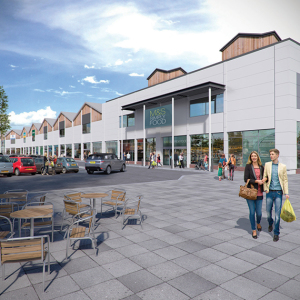 On a clear day, it is possible to look out from many vantage points, such as Portsmouth’s Spinnaker Tower or Brighton’s soon-to-open i360 and make out the French coastline. But how much will the economies of the towns and cities geographically closest to mainland Europe be affected by last month’s EU exit vote by the UK public?
On a clear day, it is possible to look out from many vantage points, such as Portsmouth’s Spinnaker Tower or Brighton’s soon-to-open i360 and make out the French coastline. But how much will the economies of the towns and cities geographically closest to mainland Europe be affected by last month’s EU exit vote by the UK public?
Brighton council leader Warren Morgan holds his hands up. “Who knows, really?” he gestures, although he suggests the tourism and financial services sectors may be at risk in his part of the coastline. The city has a £1bn seafront investment programme, including the innovative £540m extension of Standard Life’s Churchill Square shopping centre into the current conference centre, which will be rebuilt on a new site nearby.
“There is a lot of housing tied up in our development programme – and a lot of housebuilders took a big hit [after the referendum result],” says Morgan.
Although the fallout from Brexit may take months, even years, to determine, for the South East’s coastal towns, the short-term challenges remain those they have faced for decades – how to successfully adapt their leisure markets to cater to modern punters. The good news for local authorities is that interest from hoteliers and restaurateurs is on the up.
Jacqui Allen, partner at Tuffin Ferraby Taylor, says: “As values become too hot in classic destinations such as Brighton, some of the more adventurous household names in London have ventured further afield, with more and more surveying work in places like Eastbourne, St Leonards and Worthing.”
Simon Chaplin, head of restaurants at Christie & Co, agrees, pointing out that interest is not just coming from the big brands. “A number of independent operators are experiencing great success in areas such as Ramsgate, Broadstairs and Whitstable,” he says.
A key driver for this is the domino effect of people moving out of the capital and finding an abundance of large Victorian seafront properties in coastal towns. “It must seem a raving bargain to people from London,” says Fleurets associate director Simon Bland. “As this trendy, hip crowd moves in, leisure operators are drawn to these locations.”

Right now, for example, a London brasserie chain, which does not want to be identified, is scouting towns such as Eastbourne, Bexhill and Worthing as it hopes to capitalise on a lack of competition and low occupancy costs.
Landlords are also cottoning on to the potential of seaside leisure. In May, Legal & General agreed to purchase and fund the £53m development of 156,000 sq ft of retail and leisure in Dover town centre. The St James scheme, due to open next autumn, includes major retailers, a cinema, a 100-bedroom hotel and six restaurants.
And it is not just institutional investors picking up their buckets and spades. Cushman & Wakefield partner Tom Rose says: “We are seeing a pattern of private investors wanting small blocks in lot sizes of £5m-10m that can be redeveloped for retail and leisure. Some really nice clusters are being created by this type of entrepreneurial investor.”
Rooms with a view
A sure sign of the UK economy recovering is an increase in hotel openings all along the south coast. Budget operator Premier Inn, which currently has 100-bedroom hotels under construction in Bournemouth and Southampton, also has requirements in 13 other coastal towns totalling 500,000 sq ft.
Premier Inn’s head of acquisitions, Derek Griffin, says smaller coastal towns may warrant 50 rather than 200 beds, but he is keen to find sites of around one acre to house a typical 20,000 sq ft hotel.
“We’re very keen to invest in these communities,” he says. “We can be part of a catalyst – where the local authority tries to get things going.”
There are also positive signs at the top end of the market. Kevin Marsh, director of licensed leisure at Savills’ Southampton office, points to the recent opening of a Hampton by Hilton in Bournemouth and full-service Hiltons in Bournemouth and Southampton.
“This is very good news as it brings in people who are prepared to spend more money on accommodation and these people are also normally prepared to spend more on food and drink,” he says.
Andrew Moore, director of Christie & Co, reports growing demand from purchasers for hotels in secondary towns. He points to the former Salisbury Hotel in Folkestone that was sold earlier this year and is currently being refurbished as a four-star enterprise.
“If other similar hotel and guesthouse successes are anything to go by, this new hotel for Folkestone will do exceptionally well,” he says.
 Brighton’s wheel of fortune
Brighton’s wheel of fortune
Brighton’s latest attraction, the £46m i360, is due to begin rising and falling later this summer. Property people have already come up with their own variations on the ‘doughnut on a hotdog sausage’ tag coined by locals. The 200-person circular pod, designed by the architects behind the London Eye, will rise up a 450ft tower to give 26-mile views (on a good day).
It is expected to pull in 700,000 extra visitors to Brighton each year, but it is trickier to gauge the trickle-down benefits to the city’s leisure economy. Neither the council nor the private operator of the i360 appear to have made a significant assessment, although i360 suggests the attraction will bring in at least £25m of additional revenue to the city each year.
The extra footfall generated by the i360 will only increase demand from restaurant operators for what is already a very crowded marketplace. “Landlords are seeing a surge in rental values, with A3 space frequently transacting at over £60 per sq ft,” says Simon Chaplin, head of restaurants at Christie & Co.
Recent arrivals include Wahaca (which paid nearly double the value of nearby rents to secure its pitch) and Franco Manca (which paid a retailer a £300,000 premium to vacate its space).
Top tips for South East coastal towns
Robin Shepherd, partner at planning consultancy Barton Willmore, identifies the key factors that South East coastal towns need to get to grips with leisure economies
Evolve and adapt: markets that don’t will die.
Tourism has changed: there is no magic formula that all can follow, so locations should play to their strengths.
Old doesn’t necessarily mean bad or without value: heritage assets should be used as a pillar to support a town’s offer.
Use natural assets: for example, a wilderness area with lots of wildlife could become a focus for eco-tourism.
Diversity is a strength: places that are successful don’t have just one thing to do or see.
Timeframe and expectations: positive change is a long game – it doesn’t happen overnight.
Learn and be open to new ideas: identifying what others do differently can reap rewards.
Recognise the role of retail: the golden ticket is to use this to encourage people to stay a little longer.











